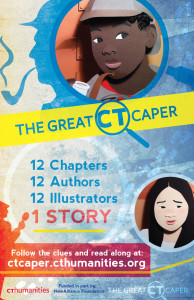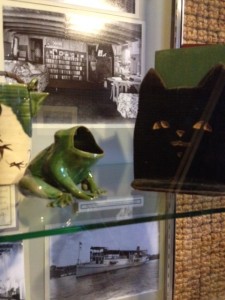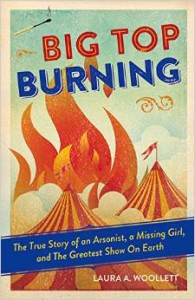Chapter 5 of The Great CT Caper is here! I don’t know about you, but I’ve been having a blast reading the Caper and seeing where all the authors have taken the story. Today we welcome Sarah Darer Littman, author of chapter 5 of the Caper, who had a week to learn and write about a place she had never visited. Welcome, Sarah!
 Research – it’s not just for school projects!
Research – it’s not just for school projects!
by Sarah Darer Littman
As a young girl living in London, I could see Baker Street Station from my bedroom window, and passed 221B Baker Street, the home of Sir Arthur Conan Doyle’s legendary fictional detective Sherlock Holmes, every time we walked to Regent’s Park.
I was a voracious reader, and the wonderful children’s librarians at the library on Marylebone Road, where my parents took us regularly, put The Hound of the Baskervilles in my hands. I was hooked.
The Great Connecticut Caper audition required authors to write a short piece from a prompt, which set up a detective entering an empty house from which a strange noise was emanating, and pulling aside a curtain. I had him find a cat behind the curtain, and it seemed only logical that the feline should be named Watson.
 At this point, despite having lived in Connecticut for many years, I knew nothing about William Gillette and his creation of the screen role of Sherlock Holmes. But it seems like I’ve been on the path to his doorstep at Gillette Castle since I spent all those hours in my bedroom down the street from 221B engrossed in the mysteries of Sherlock Holmes.
At this point, despite having lived in Connecticut for many years, I knew nothing about William Gillette and his creation of the screen role of Sherlock Holmes. But it seems like I’ve been on the path to his doorstep at Gillette Castle since I spent all those hours in my bedroom down the street from 221B engrossed in the mysteries of Sherlock Holmes.
When it came time to write my chapter, #5, I had an interesting challenge, because the story line diverged right at the end of the previous chapter, and I had very few words to account for what happened and move the parallel stories along for the next author. I’d visited Gillette Castle to learn more about William Gillette and hopefully get some fun tidbits  I might be able to use in my chapter (“Ribbit, Ribbit!” Gillette really did have two pet frogs named Mike and Lena, I learned from my tour guide). But two of the characters in my chapter, Thomas and Norm, end up at Dinosaur State Park, which I’ve never visited. We were only given a week to write our chapter, and I was about to leave on a much needed vacation, so I didn’t have time to go up to Rocky Hill for a research trip. So I went online to learn whatever I could about Dinosaur State Park, and looked up images on Google Image search.
I might be able to use in my chapter (“Ribbit, Ribbit!” Gillette really did have two pet frogs named Mike and Lena, I learned from my tour guide). But two of the characters in my chapter, Thomas and Norm, end up at Dinosaur State Park, which I’ve never visited. We were only given a week to write our chapter, and I was about to leave on a much needed vacation, so I didn’t have time to go up to Rocky Hill for a research trip. So I went online to learn whatever I could about Dinosaur State Park, and looked up images on Google Image search.
 But here’s the problem with only using online research: it’s not always correct. My original draft of chapter five involved excitement when a dinosaur statue in the field at Dinosaur State Park came to life and started chasing Thomas and Norm. But I was unsure of two things: 1) it’s been a long time since my son, now 21, was obsessed with dinosaurs and I knew every single dinosaur ever, so I wanted to check I was using the correct name and 2) I was worried because there is also a Dinosaur State Park in Texas and some of the same pictures that were tagged as being in CT were also tagged as being in Texas.
But here’s the problem with only using online research: it’s not always correct. My original draft of chapter five involved excitement when a dinosaur statue in the field at Dinosaur State Park came to life and started chasing Thomas and Norm. But I was unsure of two things: 1) it’s been a long time since my son, now 21, was obsessed with dinosaurs and I knew every single dinosaur ever, so I wanted to check I was using the correct name and 2) I was worried because there is also a Dinosaur State Park in Texas and some of the same pictures that were tagged as being in CT were also tagged as being in Texas.
 This is where being a journalist and understanding the importance of fact-checking helps me as a writer. I emailed Dinosaur State Park and explained my dilemma. I received an incredibly helpful email back from Meg Enkler, the Environmental Education Coordinator at Dinosaur State Park. Meg confirmed that the outside dinosaur statues must be at the Texas park, because the big statue of a Dilophosaurus, is indoors at Rocky Park. That nixed my existing plot line, but Meg helpfully suggested several alternatives, one of which I used. Thank you, Meg!
This is where being a journalist and understanding the importance of fact-checking helps me as a writer. I emailed Dinosaur State Park and explained my dilemma. I received an incredibly helpful email back from Meg Enkler, the Environmental Education Coordinator at Dinosaur State Park. Meg confirmed that the outside dinosaur statues must be at the Texas park, because the big statue of a Dilophosaurus, is indoors at Rocky Park. That nixed my existing plot line, but Meg helpfully suggested several alternatives, one of which I used. Thank you, Meg!
I often have to do a lot of research for my novels, and getting to ask interesting people questions about the work they do is one of the things that makes my own work so enjoyable – it’s lifelong learning.
Sarah Darer Littman is an award-winning author of books for young people. Littman’s first novel, Confessions of a Closet Catholic, won the 2006 Sydney Taylor Book Award for Older Readers. Her novel Life, After was a 2011 Sydney Taylor Honor Book. She is also the author of Purge and Want to Go Private? Her most recent novel Backlash, releases from Scholastic Press on March 31st. In addition to writing for teens, Sarah is a political columnist for CTNewsJunkie.com, and teaches creative writing in the MFA program at Western CT State College and for WritopiaLab. You can find her online at http://sarahdarerlittman.com/, @sarahdarerlitt, and https://www.facebook.com/pages/Sarah-Darer-Littman/121109781249612.





 My first book,
My first book,  many carved wooden doors, each one unique. Fiction feels its most real when the sensory details are just right. Since our story would take place at this real location, it felt important for me to experience what Li-Ming and Thomas would first hand.
many carved wooden doors, each one unique. Fiction feels its most real when the sensory details are just right. Since our story would take place at this real location, it felt important for me to experience what Li-Ming and Thomas would first hand. the plot. If the detail was not important to the scene, I cut it, even if it were true. Somewhere in Chapter 4, I took a bit of artistic license. Can you tell where?
the plot. If the detail was not important to the scene, I cut it, even if it were true. Somewhere in Chapter 4, I took a bit of artistic license. Can you tell where?





















